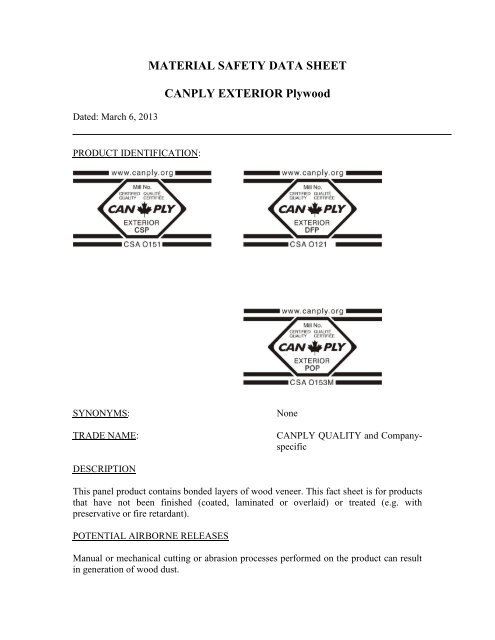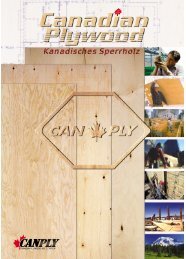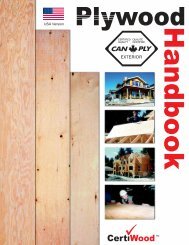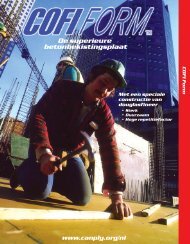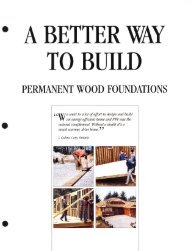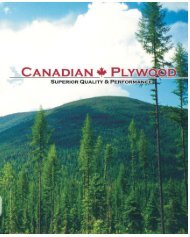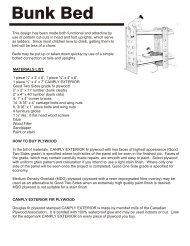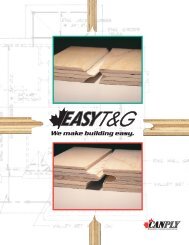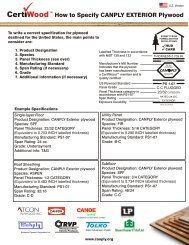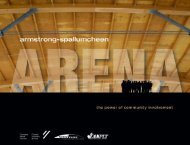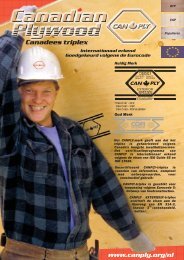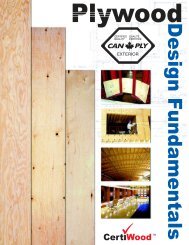MATERIAL SAFETY DATA SHEET - Canadian Plywood Association
MATERIAL SAFETY DATA SHEET - Canadian Plywood Association
MATERIAL SAFETY DATA SHEET - Canadian Plywood Association
Create successful ePaper yourself
Turn your PDF publications into a flip-book with our unique Google optimized e-Paper software.
Dated: March 6, 2013<strong>MATERIAL</strong> <strong>SAFETY</strong> <strong>DATA</strong> <strong>SHEET</strong>CANPLY EXTERIOR <strong>Plywood</strong>PRODUCT IDENTIFICATION:SYNONYMS:TRADE NAME:NoneCANPLY QUALITY and CompanyspecificDESCRIPTIONThis panel product contains bonded layers of wood veneer. This fact sheet is for productsthat have not been finished (coated, laminated or overlaid) or treated (e.g. withpreservative or fire retardant).POTENTIAL AIRBORNE RELEASESManual or mechanical cutting or abrasion processes performed on the product can resultin generation of wood dust.
PHYSICAL <strong>DATA</strong>Boiling Point ................................................. Not applicableSpecific gravity ............................................. < 1, variable, depends onspecies and moisture content.Vapour Density ............................................. Not applicable% Volatiles By Volume ................................ 0Melting Point ................................................ Not applicableVapour Pressure ............................................ Not applicableSolubility in H 2 0 (% by wt.) ......................... < 0.1%Evaporation Rate (Butyl Acetate = 1) ........... Not applicablepH .................................................................. Not applicableAppearance and odor .................................... Light to dark colour and odordependant upon wood species.FIRE AND EXPLOSION <strong>DATA</strong>Flash point ..................................................... Not applicableAutoignition Temperature ............................. Not available, however, usuallyaccepted that the ignition of woodbegins when the temperature of thewood is approximately 273 N C.(depends upon duration of exposureto heat source and other variables).Explosive Limits in Air ................................. See below under "Unusual Fire andExplosion Hazards".Extinguishing Media ..................................... Water, Carbon dioxide, SandSpecial Fire Fighting Procedures .................. NoneUnusual Fire and Explosion Hazards ............ Sawing, sanding or machining canproduce wood dust as a by-productwhich may present an explosionhazard if a dust cloud contacts anignition source. An airborneconcentration of 40 grams of dust percubic meter of air is often used as theLEL for wood dust.REACTIVITY <strong>DATA</strong>Conditions Contributing to Instability ..........Incompatibility ..............................................Stable under normal conditionsAvoid contact with oxidizing agents.Avoid open flame. Product mayignite in excess of 273C.
Hazardous Decomposition Products .............Hazardous Polymerization ............................Thermal and/or thermal oxidativedecomposition can produce irritatingand toxic fumes and gases, includingcarbon monoxide, hydrogen cyanide,aldehydes, organic acids andpolynuclear aromatic compounds.Not applicableHEALTH EFFECTS INFORMATIONExposure Limits:Wood Dust (all soft and hardwoods exceptWestern Red cedar) ....................................... NIOSH REL - TWA 1 mg/m 3Wood Dust (Softwood except Western RedCedar) ............................................................ OSHA PEL - TWA 5 mg/m 3....................................................................... OSHA PEL - STEL 10 mg/m 3....................................................................... ACGIH TLV - TWA 5 mg/m 3....................................................................... ACGIH TLV - STEL 10 mg/m 3Eye Contact ................................................... Wood dust can cause mechanicalirritation.Skin Contact .................................................. Various species of wood dust mayevoke skin irritation and allergiccontact dermatitis in sensitizedindividuals.Ingestion ........................................................ Not likely to occur.Wood Dust Inhalation:Wood dust may aggravate pre-existing respiratory conditions and allergies.AcuteHealth hazards may include respiratory irritation, nasal dryness, coughing, wheezing andsneezing.ChronicHealth hazards include respiratory sensitization and/or irritation. IARC classifies wooddust as a carcinogen to humans (Group1). This classification is based primarily onIARC’s evaluation of increased risk in the occurrence of adenocarcinomas of the nasalcavities and paranasal sinuses associated with exposure to wood dust. IARC did not findsufficient evidence to associate cancers of the oropharynx, hypopharynx.lung, lymphaticand hematopoietic systems, stomach colon or rectum with exposure to wood dust. TheNational Toxicology Program lists wood dust as a known human carcinogen in the NTP’stenth Report on Carcinogens.
PRECAUTIONS, SAFE HANDLINGWood Dust: Avoid dusty conditions and provide good ventilation.GENERALLY APPLICABLE CONTROL MEASURESVentilation: Provide adequate general and local exhaust ventilation to keep airbornecontaminant concentration levels below the OSHA PELs when panel product is subjectedto manual or mechanical cutting as abrasion processes resulting in generation of wooddust.Personal Protective Equipment: Wear goggles or safety glasses when manufacturingor machining the product. Wear NIOSH/MSHA approved respirator when the allowableexposure limits may be exceeded. Other protective equipment such as gloves and outergarments may be needed depending on dust conditions.EMERGENCY AND FIRST AID PROCEDURESEyes ...............................................................Skin ...............................................................Inhalation ......................................................Ingestion ........................................................Flush eyes with large amounts ofwater. Remove to fresh air. Ifirritation persists, get medicalattention.Wash affected areas with soap andwater. Get medical advice if rash orpersistent irritation or dermatitisoccurs.Remove to fresh air. Get medicaladvice if persistent irritation, severecoughing or breathing difficultyoccurs.Not applicableIMPORTANT: The information and data herein are believed to be accurate and havebeen compiled from sources believed to be reliable. It is offered for your consideration,investigation and verification. The CertiWood Technical Centre (CertiWood) makes nowarranty of any kind, express or implied, concerning the accuracy of completeness of theinformation and data herein. CertiWood will not be liable for claims relating to anyparty's use of or reliance on information and data contained herein regardless of whetherit is claimed that the information and data are inaccurate, incomplete or otherwisemisleading. It is incumbent upon the user to obtain the most up-to-date information.CONTACT : For further information contact the Certiwood Technical Centre at (604)981-4190.


